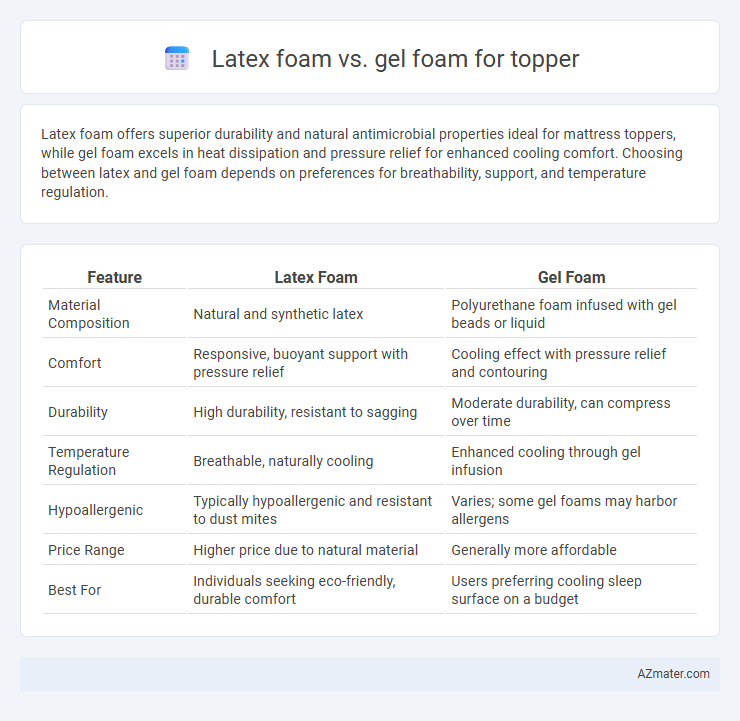Latex foam offers superior durability and natural antimicrobial properties ideal for mattress toppers, while gel foam excels in heat dissipation and pressure relief for enhanced cooling comfort. Choosing between latex and gel foam depends on preferences for breathability, support, and temperature regulation.
Table of Comparison
| Feature | Latex Foam | Gel Foam |
|---|---|---|
| Material Composition | Natural and synthetic latex | Polyurethane foam infused with gel beads or liquid |
| Comfort | Responsive, buoyant support with pressure relief | Cooling effect with pressure relief and contouring |
| Durability | High durability, resistant to sagging | Moderate durability, can compress over time |
| Temperature Regulation | Breathable, naturally cooling | Enhanced cooling through gel infusion |
| Hypoallergenic | Typically hypoallergenic and resistant to dust mites | Varies; some gel foams may harbor allergens |
| Price Range | Higher price due to natural material | Generally more affordable |
| Best For | Individuals seeking eco-friendly, durable comfort | Users preferring cooling sleep surface on a budget |
Introduction: Understanding Latex Foam and Gel Foam Toppers
Latex foam toppers offer natural resilience and breathability, providing consistent support and pressure relief through durable, hypoallergenic materials derived from rubber trees. Gel foam toppers incorporate cooling gel-infused memory foam, designed to regulate temperature and contour closely to the body for enhanced comfort and reduced heat retention. Both latex and gel foam toppers improve mattress performance by addressing comfort and support, but differ significantly in material composition and thermal properties.
Material Composition: What Are Latex Foam and Gel Foam?
Latex foam is made from natural or synthetic rubber, providing a resilient, breathable, and hypoallergenic surface ideal for mattress toppers. Gel foam combines polyurethane foam infused with gel beads or swirls, designed to enhance cooling and pressure relief characteristics. Both materials offer distinct benefits in terms of durability, temperature regulation, and comfort support for sleep enhancement.
Comfort and Support: Comparing Pressure Relief
Latex foam toppers provide exceptional pressure relief by conforming closely to the body while maintaining resilient support that reduces pressure points and promotes spinal alignment. Gel foam toppers incorporate cooling gel particles to dissipate heat and offer a softer, more cushioning feel, enhancing comfort for side sleepers or those who prefer plush support. Both materials excel in pressure relief, but latex foam is superior in offering balanced support and durability, while gel foam prioritizes temperature regulation and softness.
Temperature Regulation: Heat Retention vs Cooling Features
Latex foam toppers offer excellent temperature regulation due to their natural breathability and open-cell structure, which promotes airflow and reduces heat retention for a cooler sleep environment. Gel foam toppers incorporate cooling gel beads or layers designed to absorb and dissipate body heat, providing targeted cooling benefits that prevent overheating. While latex foam ensures consistent ventilation, gel foam excels in actively drawing heat away, making each material suitable for different temperature preferences.
Durability and Longevity: Which Topper Lasts Longer?
Latex foam toppers exhibit superior durability due to their natural resilience and ability to retain shape over time, often lasting 8-10 years with consistent use. Gel foam toppers, infused with cooling gel particles, provide enhanced comfort but typically have a shorter lifespan of around 3-5 years as the gel can break down and foam density may decrease. Overall, latex foam toppers offer greater longevity and sustained support, making them a more durable investment for long-term mattress enhancement.
Hypoallergenic Properties and Health Considerations
Latex foam toppers are naturally hypoallergenic, resistant to dust mites, mold, and bacteria, making them ideal for allergy sufferers and those with respiratory sensitivities. Gel foam toppers often incorporate polyurethane foam infused with gel beads, which may not provide the same level of allergen resistance and can off-gas volatile organic compounds (VOCs). Choosing latex foam supports better indoor air quality and reduces exposure to allergens and potentially harmful chemicals, promoting healthier sleep environments.
Motion Isolation: Reducing Partner Disturbance
Latex foam toppers provide excellent motion isolation due to their natural resilience and buoyant properties, minimizing partner disturbance during sleep. Gel foam toppers also offer good motion isolation by combining memory foam's contouring ability with cooling gel beads, which helps absorb and reduce motion transfer. Choosing between latex and gel foam depends on preference for natural materials versus enhanced cooling features while maintaining effective motion isolation.
Firmness Levels: Customization Options
Latex foam toppers provide varying firmness levels ranging from soft to extra firm, allowing precise customization based on natural latex density and Talalay or Dunlop processing. Gel foam toppers often combine memory foam with gel infusions, offering medium-firm support with moderate contouring, ideal for pressure relief but limited in firmness variation. Latex foam's responsiveness and durability enable broader customization for personalized comfort compared to gel foam's focus on cooling and moderate firmness.
Environmental Impact and Sustainability
Latex foam toppers are derived from natural rubber, making them biodegradable and more environmentally sustainable compared to synthetic alternatives; they also often come from renewable resources with lower carbon footprints. Gel foam toppers, typically made from polyurethane infused with gel particles, rely on petroleum-based chemicals that contribute to higher environmental pollution and are less biodegradable. Choosing latex over gel foam supports eco-friendly practices through reduced chemical use, enhanced recyclability, and lower emissions throughout the product lifecycle.
Price Comparison and Value for Money
Latex foam toppers typically cost more upfront than gel foam toppers, reflecting their natural materials and durability. Gel foam toppers offer an affordable option with effective cooling properties, making them a budget-friendly choice for enhancing mattress comfort. Considering long-term use, latex foam provides better value for money due to its resilience and longevity despite the higher price point.

Infographic: Latex foam vs Gel foam for Topper
 azmater.com
azmater.com